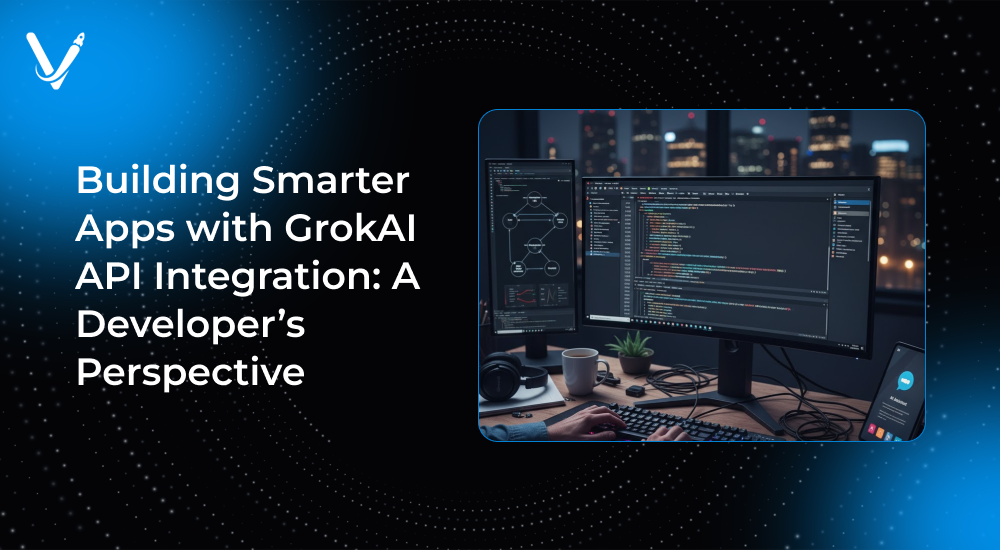Building Smarter Apps with GrokAI API Integration: A Developer’s Perspective


- Nov 4, 2025



Key Takeaways
In today’s fast-evolving digital ecosystem, applications are no longer judged by design or functionality alone—they are evaluated by how intelligently they respond to users. The era of static interfaces has shifted toward smart, adaptive systems that anticipate user intent, deliver personalized recommendations, and automate complex workflows. This evolution has sparked a new wave of innovation, with GrokAI API leading the charge.
For developers, integrating GrokAI is like adding a new dimension of intelligence to their applications. It enables them to move beyond hard-coded logic and create adaptive systems that understand context, interpret natural language, and act autonomously on data insights. GrokAI’s API-driven architecture simplifies this transformation, offering developers easy-to-use endpoints for tasks like data prediction, sentiment analysis, conversation handling, and cognitive automation.
In this article, we’ll explore how developers can harness GrokAI API integration to build smarter, more efficient, and future-ready applications. We’ll dive into its capabilities, implementation best practices, use cases, performance optimization strategies, and the role of intelligent design in driving app success.
At its core, GrokAI is an advanced artificial intelligence framework that combines machine learning, natural language processing, and predictive analytics into a single API ecosystem. It helps developers integrate high-level intelligence into their applications without building complex AI models from scratch.
What makes GrokAI unique is its ability to “grok”—to deeply understand data and behavior patterns. Instead of merely reacting to commands, GrokAI analyzes context, intent, and semantics to deliver meaningful outputs. This makes it ideal for modern applications that thrive on real-time insights and conversational experiences.
Also read: Grok vs Siri vs Google Assistant: Who Wins in 2025?
For developers, these capabilities mean one thing—less time building AI from the ground up and more time innovating.
In a world driven by personalized digital experiences, applications must go beyond static logic. GrokAI API enables developers to embed intelligence into every layer of their app—data processing, UI interaction, decision-making, and automation.
Here’s why GrokAI stands out:
Traditional AI model building involves large datasets, preprocessing, training, and fine-tuning—a process that can take months. GrokAI abstracts this complexity. Developers can integrate ready-made AI modules with just a few lines of code, allowing them to focus on product logic and user experience.
GrokAI’s API-first approach supports multiple environments including Python, Node.js, React, Swift, and Kotlin. It fits seamlessly into existing tech stacks without requiring heavy architectural overhauls.
With GrokAI’s predictive algorithms, apps can evaluate vast amounts of data and make intelligent suggestions—be it for e-commerce recommendations, healthcare diagnostics, or manufacturing process optimization.
Since GrokAI operates on an API model, developers pay only for usage. This eliminates the need for maintaining expensive infrastructure or data science teams, making it ideal for startups and enterprises alike.
Built with enterprise-grade encryption and compliance standards, GrokAI ensures that sensitive data—especially in industries like fintech and healthcare—remains protected during every API interaction.
Integrating GrokAI into an existing application is designed to be developer-friendly. The API architecture is REST-based, ensuring compatibility with modern frameworks and tools. Here’s a simplified workflow that demonstrates the integration process conceptually:
Every developer begins with API key authentication, which establishes a secure communication channel. Once registered on the GrokAI dashboard, developers receive unique keys to authorize requests and manage usage.
Developers define input parameters based on use cases—this could be user messages, datasets, sensor inputs, or structured records. GrokAI’s context-awareness ensures that it interprets not just data, but also intent.
After sending a request via POST or GET, GrokAI processes it using deep learning models and returns structured, actionable results—predictions, classifications, summaries, or generated text.
Developers can embed these responses directly into user interfaces, automation scripts, or backend workflows, enabling real-time intelligence and seamless user experiences.
The API supports adaptive learning—analyzing user feedback and improving over time without manual retraining.
Smart applications rely on dynamic features that evolve with user needs. Here are some real-world applications of GrokAI API across industries and use cases that developers can implement effortlessly.
By leveraging GrokAI’s natural language understanding (NLU), developers can build chatbots and virtual assistants that respond naturally, remember previous interactions, and deliver contextual support. Businesses can use it to automate customer service or create interactive learning tools.
In e-commerce and media apps, GrokAI analyzes user activity to suggest relevant products or content, similar to the recommendation engines of Netflix or Amazon—but with less overhead.
In IoT and manufacturing, GrokAI API processes data from sensors and predicts equipment failures before they occur. This proactive intelligence minimizes downtime and increases operational efficiency.
For finance, healthcare, and logistics, GrokAI enables applications to monitor transactions, patient data, or delivery routes in real-time—spotting anomalies and recommending corrective actions instantly.
For social media or feedback-driven platforms, GrokAI API can detect emotions and sentiments in user reviews, providing valuable insights into customer satisfaction and engagement.
Developers appreciate GrokAI not just for what it does, but how it works. Its architecture is built to deliver low-latency, scalable, and secure AI services.
GrokAI’s architecture separates model inference, data preprocessing, and context management into modular layers, allowing developers to use only what they need.
The API runs on distributed cloud infrastructure, supporting automatic scaling during high-traffic periods. Developers can integrate it with AWS, Azure, or Google Cloud for seamless deployment.
For chatbots or real-time dashboards, GrokAI maintains temporary context sessions, so users can enjoy coherent interactions across multiple requests.
Sensitive user information is processed using anonymization protocols, ensuring compliance with GDPR, HIPAA, and enterprise-level security standards.
Building with GrokAI is straightforward, but following best practices can maximize efficiency, scalability, and user satisfaction.
Before integration, identify the specific problem the API will solve—be it personalization, automation, or analytics. This helps streamline implementation and optimize performance.
Clean, structured data produces better AI results. Preprocess user inputs to remove noise, outliers, or irrelevant context before sending them to GrokAI.
Always account for fallback scenarios. If the API fails or latency occurs, have predefined defaults to ensure a smooth user experience.
Use GrokAI’s developer dashboard or custom analytics to track API performance, user behavior, and cost metrics.
Store API keys securely using environment variables and HTTPS protocols. Avoid exposing credentials in client-side code.
To truly understand the potential of GrokAI, let’s explore how developers across different sectors are transforming their products with this integration.
An online retailer integrated GrokAI to personalize shopping experiences. The system analyzed browsing habits, purchase history, and search patterns to generate tailored recommendations, increasing conversions by 35%.
A telemedicine app used GrokAI for real-time symptom analysis and preliminary diagnostics. It improved consultation efficiency and helped healthcare professionals prioritize cases more effectively.
Manufacturers adopted GrokAI to process machine sensor data. The API predicted faults hours before failure, reducing downtime and saving thousands in maintenance costs.
E-learning platforms used GrokAI to deliver adaptive content based on learner performance and preferences, enhancing engagement and retention rates.
Fintech startups integrated GrokAI for fraud detection and predictive analytics, empowering financial analysts to make faster, more accurate decisions.
As with any intelligent system, performance optimization ensures consistent and reliable experiences. Developers integrating GrokAI can follow these strategies:
As artificial intelligence continues evolving, GrokAI’s ecosystem is expanding toward autonomous reasoning, cross-domain understanding, and real-time multimodal processing. Developers can look forward to integrating voice, image, and data inputs into unified AI workflows—enabling apps that can see, hear, and think simultaneously.
Moreover, the rise of Edge AI and federated learning will make GrokAI even more powerful by allowing decentralized intelligence processing on devices. This means faster responses, stronger privacy, and greater independence from cloud reliance.
In the near future, GrokAI will not just be an API—it will be a development philosophy that empowers creators to build applications that truly understand their users.
The journey to smarter applications starts with the right tools—and GrokAI API offers exactly that. Its intelligent, context-aware capabilities transform ordinary apps into dynamic ecosystems that learn, adapt, and evolve. For developers, it removes the barriers of traditional AI complexity, opening the door to faster innovation and scalable intelligence.
By integrating GrokAI, you’re not just improving an app—you’re elevating the entire user experience with intelligence that feels intuitive and human. It’s an opportunity to redefine what applications can do when they truly understand context and purpose.
If you’re ready to take your app development to the next level, partner with Vasundhara Infotech—a leading expert in AI-powered application development and API integration. Our teams specialize in GrokAI, machine learning systems, and full-stack solutions that make innovation effortless.
Copyright © 2025 Vasundhara Infotech. All Rights Reserved.